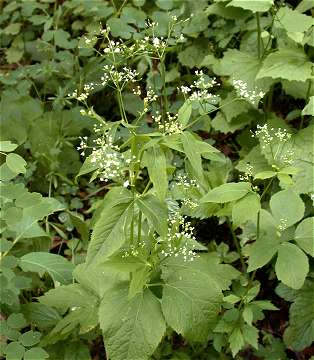

Cryptotaenia canadensis - (image 1 of 5)
Taxonomy
Family: Apiaceae
Habitat
Upland woods, floodplain forest, often increasing with disturbance.
Associates
Acer saccharum, Claytonia virginica, Crataegus mollis, Galium aparine, Geranium maculatum, Geum canadense, Hydrophyllum virginianum, Ribes missouriense, Sanicula gregaria, Smilacina racemosa, Smilax lasioneura, Tilia americana, Viola sororia, Vitis riparia.
Distribution
Quebec and New Brunswick west to Manitoba, south to GA, AL, and TX. Also occurs in Japan.
Morphology
Fibrous-rooted perennial to 1 m; stem single. Leaves to 15 cm long, palmately divided into 3 leaflets; leaflets toothed, often lobed. Flowers tiny, white, in uneven clusters, born on stalks of variable length. Fruits dark, oblong, ribbed.
Notes
Flowers late May to mid September
Wetland indicator: Facultative
Also called Wild Chervil. The leaves can be used like parsley or boiled and eaten as greens. The roots can be prepared like parsnips.
References
Gleason, Henry A.
and A. Cronquist. 1991. Manual of Vascular Plants of Northeastern United States
and Adjacent Canada. Second Ed.
The New York Botanical Garden. Bronx, NY
Niering, W. A. 1979. The Audubon society field guide to North American
wildflowers: eastern region.
Knopf/Random House, New York.
Peterson, L. A. 1977. A Field Guide to Edible Wild Plants: Eastern and central North America
Houghton Mifflin Company. New York, NY
Swink, F. and G. Wilhelm. 1994. Plants of the Chicago Region.
Indiana Academy of Science. The Morton Arboretum. Lisle, Illinois.
|
Michael Hough © 2004 |